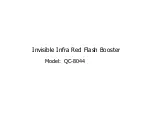
30
ķ
shortened. Thereafter repeat the test flash.
The f-stop established in this manner also has to be set on the
camera.
Direct the flash unit with its sensor for the test flash in the same man-
ner as for the subsequent flash shot.
3. Automatic Flash Mode
In the automatic flash mode the sensor
(fig. 1) measures the light reflected
from the subject. The flash is cut off as soon as sufficient light has been emit-
ted for correct exposure.
In this manner there is no need to calculate and set a new aperture when the
distance is changed, provided that the subject remains within the indicated
automatic flash range.
The photosensor of the flashgun must be directed at the subject, regardless of
the direction at which the main reflector is pointing. The photosensor has a
measuring angle of approx. 25°, and it only measures the actual amount of
light emitted by the flashgun.
Six working apertures are available in the automatic flash mode.
Adjusting procedure for the automatic flash mode:
Example:
Flash-to-subject distance: 5 m
Film speed: ISO 100/21°
• Adjust the camera according to the manufacturer’s operating instructions.
• Switch on the flashgun with the main switch
(fig. 5) .
• Set the film speed with the setting knob
(fig. 3) on the flashgun’s handle.
• Set the indicator window
(fig. 3) for one of the “C” auto apertures.
The minimum lighting distance is approx. 10% of the maximum flash ran-
ge.
• Await flash readiness indication – The flash ready indicator
lights up
(fig. 3)
☞
The subject should be within the middle third of the distance range.
This gives the electronic control sufficient scope for compensation
should this be necessary.
There is a certain measure of overlap between the individual automatic aper-
tures. As a result of this overlap it is always possible to place the subject wit-
hin the middle third of the range.
CAUTION with zoom lenses!
Due to their design they can cause a loss of light in the order of up to
one f-stop. Furthermore, the effective aperture can also vary, depen-
ding upon the adjusted focal length. This must be compensated by
manually correcting the aperture setting on the flashgun!
4. Manual Flash Mode
In this mode the flashgun will emit its full power. The flashgun can be adap-
ted to the actual picture shooting situation by setting the corresponding aper-
ture on the camera.
If the displayed value does not coincide with the actual distance, then the
aperture have to be changed accordingly.
Adjusting procedure for the manual flash mode:
Example:
Flash-to-subject distance: 15 m
Film speed: ISO 100/21°
• Set the camera as indicated in the camera’s operating instructions.
• Turn on the flash unit with the main switch
(fig 5).
• Set the film speed with the setting knob
(fig. 3) on the flash handle.
• Set the indicator window
(fig. 3) at “M”.
The distance will then be opposite an f-number. This f-number is the apertu-
re to be set.
• Await flash readiness indication – The flash ready indicator
(fig. 3)
lights up.
At a flash-to-subject distance of 15 m (as in our example), an aperture
☞
☞
☞
















































